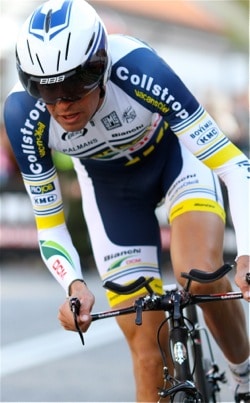Cycling training forces your body to make both central and peripheral adaptations to the physical demands. Central adaptations are increases in both blood volume and total hemoglobin (Hb). The Hb concentration, better known as hematocrit, remains unchanged or even slightly lower for top athletes. The total blood volume increases after a few days of training due to an increased plasma volume. Later on there will be an increase in the amount of red blood cells (erythrocyts). An increase in the total blood volume is very useful since that will make the stroke volume larger. Thus, the heart can pump more oxygen transporting cells out for every stroke it makes and works more efficient. Since the maximal heart rate remains unchanged the maximal cardiac output is increased. This is a very important adaptation to cycling training. There is no difference in the (a-v) O2 uptake between welltrained cyclists and untrained. It is simply not possible to deoxygenate a larger percentile out in the capillaries. Thus, the delivery of hemoglobin is mainly dependent of the maximal cardiac output.
Adaptations in the heart
The higher stroke volume achieved through cycling training is mainly caused by an increase in the cardiac chamber size and an expanded total blood volume. The heart adapts specifically to the physical demands met during training session. A weight lifter will not get a larger chamber, but instead have a thicker wall in the left ventricle. This adaptation is supposed to meet the requirements for heavy lifting with high blood pressures. Remember that the heart is a muscle itself and needs training. Also it becomes better for what it is trained. So if a top cyclist decides to stop training or get injured, their heart will return back towards normal proportions. Just like any other muscle the heart needs regular training to maintain its fitness.
Hypertrophy is not the only adaptation in the cardiac system. The ventricle gets more compliant which means there is less resistance during filling. This allows stroke volume to increase and less work for the heart. And more importantly it also allows the heart to maintain an increased stroke volume during hard exercise. It is not possible to train your maximal heart rate, that factor will never grow, it might even decrease slightly for elite cyclists. To increase the maximal cardiac output you have to increase the strokevolume. Remember that cardiac output = stroke volume x heart rate.
The coronary vascular system is increased to meet the increased O2 demand for the larger ventricle.
Resting heart rate
You will probably already have noticed that your resting heart is lower when you are in good shape. This is because of a larger stroke volume or more correctly a bigger parasympathic drive on the sinus node. It is easy to monitor your resting heart rate, just put on your Polar rim when you wake up and relaxe for a couple of minutes. You will quickly discover that your heart rate is influenced by many factors. Physical or emotional stress gives a nervous response that accelerates the pulse. Different stress hormones also affect the heart rate. A good reason to know your normal level of resting heart rate is that you can use it to discover overtraining or illness. If your resting heart rate is 10-15 beats above normal, you might have a disease. In that case I will recommend you take your temperature and look for other symptoms. Avoid intensive training or races if you don´t feel well.
Remember that your resting and maximal heart rate are not comparable with your friends heart rates. Therefore you have to know your own heart rates because these are the only beats to worry about.
Sponsor: Great deals on beach cruiser bicycles
Respiratory adaptations to cycling training
Training has only a little if any affect on the pulmonary system. You do not get a large lung capacity from training, you get it from your parents. Very specific training of the inspiratory muscles might increase the vital capacity about 3%.
Cyclists have a slower breathing rate than non-cyclists because of a larger tidal volume. This makes their breathing more efficient. Cyclists are able to achieve a smaller end-expiratory volume and larger end-inspiratory volume because their respiratory muscles are stronger and more fatigue-resistant. During exercise plasma lactate will increase and raise your ventilatory rate to wash out CO2 and stabilize pH. The primary respiratory changes with training are more likely secondary to a reduced lactate production during exercise. The ventilatory rate is primarly driven by the level of CO2.

